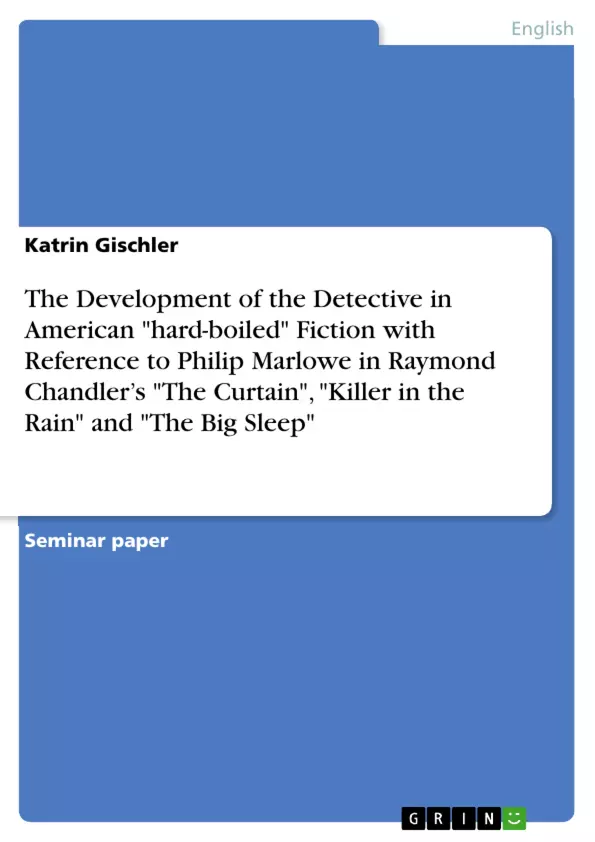Raymond Thornton Chandler started his career as a crime novelist relatively late in 1933 at the age of 45 (Widdicombe, xvi). With the foundation of the Black Mask Magazine, Chandler, as well as many other writers, got the chance to test his talent as a crime novelist and simultaneously to raise some money. His first stories were miniature novels which were strongly influenced by his British sophistication and education (Phillips, 17). But he was aware of the fact that he had to veil his style of writing in order to make it acceptable to the American readers, especially the Black Mask readers (Phillips, 17). During 1933 and 1939 Chandler published 20 detective stories in several “pulp magazines” until he wrote his first novel The Big Sleep (Neumeyer, 329). By writing longer fiction Chandler had to portray his characters fully and give an authentic sense of the world, whereas the short story allowed him to rely on action (MacShane, 63).
Chandler’s ambition was to mark off from the English detectives of Agatha Christie and Dorothy Sayers, i.e. to create a reliable character that would “leave scars” and transfer what he calls a “’half-poetical emotion’ that is the heart of the work” (MacShane, 69). This kind of reliability became one of Chandler’s dogmas and occurs not only in his creation of characters and plot but also in the historical background of the stories. In the following paper I’m going to analyze the origin and development of the private-eye in general. I will focus my analysis on the development of the detective in American “hard-boiled” fiction with reference to Philip Marlowe in Raymond Chandler’s “The Curtain”, “Killer in the Rain”, and the novel The Big Sleep. The choice relies on the fact that The Big Sleep and its character Philip Marlowe evolved from the two short stories. The question also includes how Marlowe is characterized throughout the stories.
Table of Contents
- Introduction
- The way to American "hard-boiled" fiction
- The origins
- "The Golden Age of the Detective Novel"
- American "hard-boiled" fiction
- The "tough guy"
- The creation of Philip Marlowe
- The Metamorphosis
- The sleuth's moral
- The chivalrous knight
- Protection of the client
- Women
- Conclusion
- Works Cited
Objectives and Key Themes
This paper analyzes the development of the private detective in American "hard-boiled" fiction, focusing on the evolution of Philip Marlowe in Raymond Chandler's "The Curtain," "Killer in the Rain," and "The Big Sleep." The paper examines the characteristics of Marlowe and how he differs from the more traditional English detective archetype. It explores the transition from the "Great Detective" of the 19th century to the "tough guy" of American crime fiction.
- The origins of the detective short story
- The development of the "tough guy" detective in American fiction
- The characteristics of Philip Marlowe as a detective
- The influence of English crime fiction on American "hard-boiled" fiction
- The realism and authenticity of American crime fiction
Chapter Summaries
The paper begins by tracing the origins of the detective short story back to Edgar Allan Poe's "The Murders in the Rue Morgue." It discusses the analytical mind of Auguste Dupin and his detachment from the case. The paper then explores the development of the "tough guy" detective in American fiction, highlighting the realism and authenticity of these stories compared to their English counterparts. It concludes by analyzing the character of Philip Marlowe in Raymond Chandler's works, emphasizing his distinct characteristics and how he deviates from the traditional English detective archetype.
Keywords
The paper explores the keywords "detective," "hard-boiled fiction," "Philip Marlowe," "Raymond Chandler," "tough guy," "realism," and "American crime fiction." It examines the characteristics of these genres and the evolution of the detective character in American literature.
- Quote paper
- Katrin Gischler (Author), 2004, The Development of the Detective in American "hard-boiled" Fiction with Reference to Philip Marlowe in Raymond Chandler’s "The Curtain", "Killer in the Rain" and "The Big Sleep", Munich, GRIN Verlag, https://www.grin.com/document/47130



